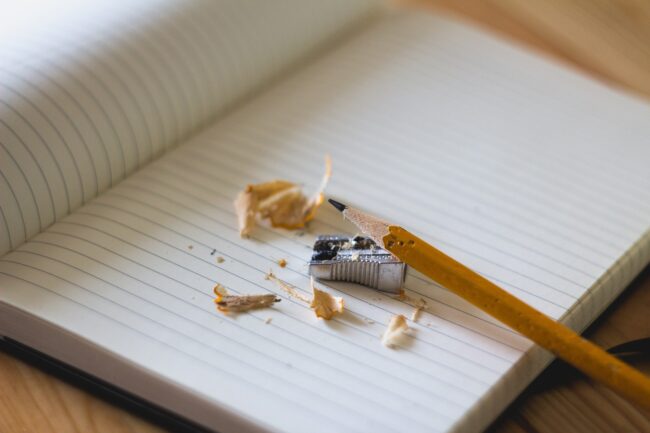Table of Contents
Dogs love to chew on things they shouldn’t. A surprisingly common household item that canines sink their teeth into is the humble pencil. Whenever they find a pencil, some dogs like to crunch it apart, leaving the evidence all over the carpet.
So should you worry if your dog ate a pencil? Should you worry about the lead inside the pencil? In this article, we show you everything you need to know.
Are Pencils Toxic to Dogs?
Modern pencils have three components. The first is the outer plastic layer, the second is the wood layer, and the third is the inner graphite layer.
The plastic layer is there to protect the wood from moisture damage. The wood layer provides strength to the pencil and the graphite inside. The latter allows you to write and draw on paper.
So the first worry to cast aside is the myth of “lead” inside lead pencils. In this case, lead simply refers to a pencil with a graphite interior – there is no actual metal. Despite the name, dog owners do not have to worry that their dogs will get lead poisoning.
But what about the other components? The wood might be the main concern here. Not only is it not digestible but the pencil is almost guaranteed to splinter into smaller pieces. If the splinters are sharp enough, they can cause internal bleeding. The larger parts can cause blockages.
Types of Pencils
In the market, you’re going to find different types of pencils. So you need to know which pencil your dog just consumed.
The first type is a charcoal pencil. These pencils have charred vines and other woody materials in their body. Both of these are safe and shouldn’t pose any significant threat other than wood splinters that might cause internal bleeding.
The second type is graphite pencils. As we already discussed, this substance isn’t likely to pose any threat either.
The final type is colored pencils, and they contain dyes that provide them with their color. These can be toxic if ingested in high amounts. The same is true for crayons.
Symptoms to Watch Out For
So what symptoms do you need to look out for when your dog accidentally consumed pieces of a pencil?
If you can find all the pieces, you breathe a sigh of relief. Your dog didn’t ingest any splinters. Even so, keep an eye on them as a tiny fragment might’ve been swallowed nonetheless. But overall, most dogs prefer to spit out a pencil rather than swallow the pieces.
But in other cases, you’ll see complications like vomiting and straining to do their business in the yard. When a lot of pencil pieces obstruct the digestive tract, food cannot move normally and in most cases, this could result in vomiting.
Likewise, if the pieces obstruct the digestive tract towards the lower side, it will affect the defecation process. Your dog will find it harder to poop. In severe cases, this can cause internal bleeding in the rectum area.
Other than that, abdominal discomfort and lingering pain might also become obvious signs that something is wrong.
Actions to Take When Dogs Eat Pencils
In most cases, the pieces will pass through the digestive tract with no issues. Make sure your dog consumes enough liquids to make the process easier for it.
But if you see any of the symptoms after your dog has consumed the pencil pieces, you need to contact your vet at the earliest.
Since there’s a chance of internal bleeding, the vet might use endoscopy to view your dog internally. The vet will also ask you specific questions to determine the amount your pet had consumed. The vet may also order X-rays to spot any damage that the pencil pieces may have caused. If there are such troubles, the vet will have to perform surgery to remove the blockage and treat the damage. If the blockage isn’t severe, the vet may recommend food items that will help to clear the problem up.
What About the Pencil’s Eraser?
Some lead pencils have erasers. Should you worry upon noticing that your dog had also swallowed this part of the pencil?
The good news is that erasers seldom cause problems. They are too small to cause a blockage on their own and most dogs prefer to spit them out anyway.
Most modern erasers consist of synthetic rubber and plastic. Your dog will not be able to digest these components, meaning that it will either barf or poop the eraser out at some point.
A Quick Summary
We use pencils for a lot of things – school, study, and art. As a pet parent, you should ensure that your dog doesn’t have access to your stationery. The best way is to store pencils in high or concealed places, like a shelf or inside a pencil box that isn’t easy to open for pets. Most pencil components aren’t likely to cause a medical emergency but if your dog chewed on a pencil, closely watch it for signs of trouble – and contact a vet when you notice anything is wrong.

